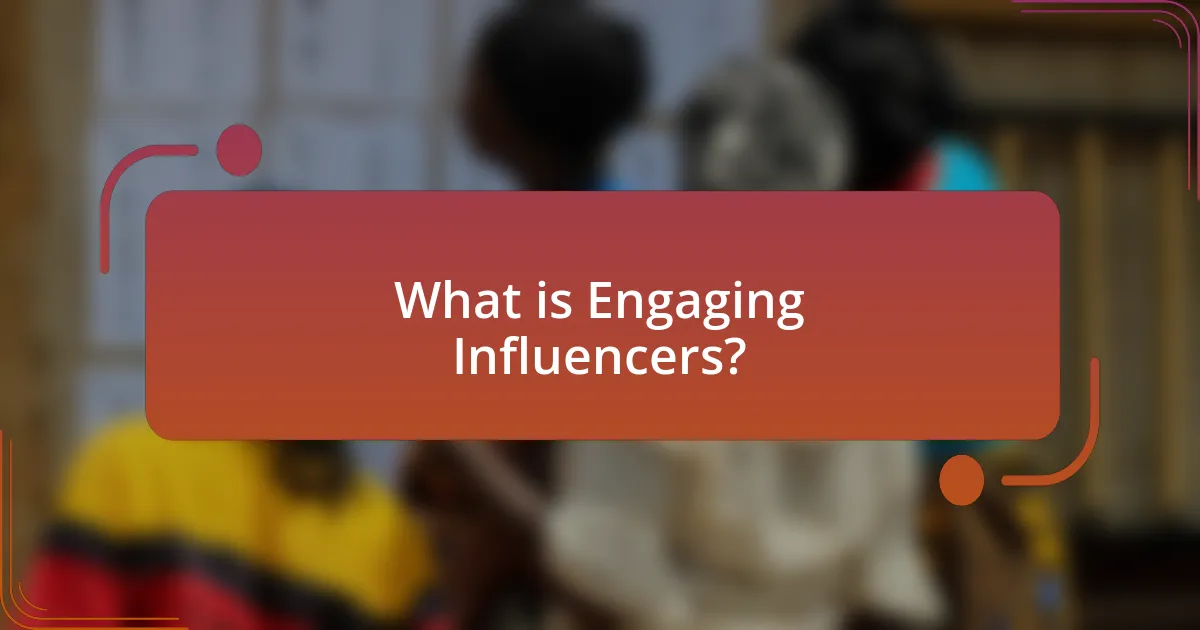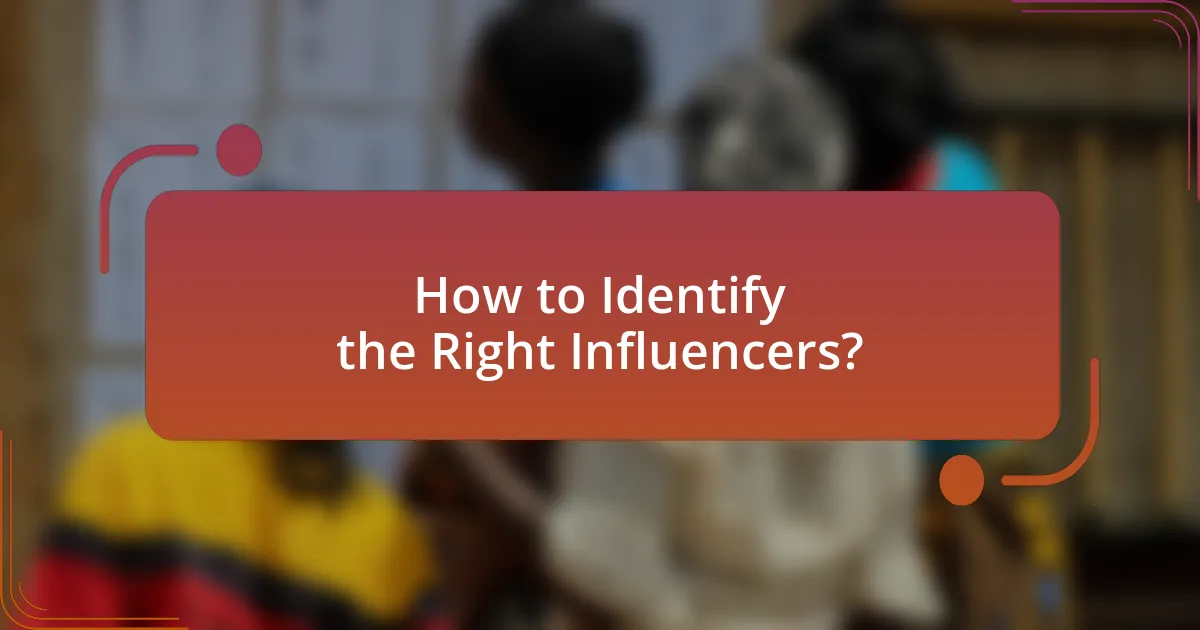Engaging influencers refers to the strategic collaboration with individuals who possess significant influence over specific audiences to promote products, services, or campaigns. This article explores the impact of influencers on marketing campaigns, highlighting their ability to enhance brand visibility and credibility, as well as the various types of influencers, including mega, macro, micro, and nano influencers. It discusses the importance of audience alignment and authenticity in influencer selection, the metrics for evaluating influencer performance, and strategies for effective engagement. Additionally, the article addresses common challenges brands face in influencer marketing and offers practical tips for successful campaigns, emphasizing the need for clear communication and mutual benefit in influencer partnerships.

What is Engaging Influencers?
Engaging influencers refers to the strategic process of collaborating with individuals who have a significant following and influence over a specific audience to promote products, services, or campaigns. This approach leverages the credibility and reach of influencers to enhance brand visibility and drive consumer engagement. Research indicates that 49% of consumers depend on influencer recommendations when making purchasing decisions, highlighting the effectiveness of this marketing strategy.
How do influencers impact marketing campaigns?
Influencers significantly impact marketing campaigns by enhancing brand visibility and credibility. Their established trust with followers allows brands to reach targeted audiences effectively, often resulting in higher engagement rates. For instance, a study by the Digital Marketing Institute found that 49% of consumers depend on influencer recommendations when making purchasing decisions. Additionally, campaigns that incorporate influencers can see up to 11 times higher return on investment compared to traditional advertising methods, as reported by the Influencer Marketing Hub. This demonstrates that influencers not only amplify brand messages but also drive measurable business outcomes.
What types of influencers exist in the market?
There are several types of influencers in the market, categorized primarily by their audience size and niche. These include mega influencers, who have over a million followers and often include celebrities; macro influencers, with 100,000 to 1 million followers, typically known for their expertise in specific areas; micro influencers, who possess 1,000 to 100,000 followers and are recognized for their authenticity and engagement; and nano influencers, with fewer than 1,000 followers, who often have a highly engaged and niche audience. This classification is supported by industry reports indicating that micro and nano influencers tend to have higher engagement rates compared to their larger counterparts, making them valuable for targeted marketing campaigns.
How do different influencer types affect audience engagement?
Different influencer types significantly affect audience engagement through varying levels of trust, relatability, and reach. For instance, micro-influencers, who typically have between 1,000 to 100,000 followers, often achieve higher engagement rates (up to 7% on average) compared to macro-influencers with larger followings, due to their perceived authenticity and closer connections with their audience. Research by the marketing firm Markerly indicates that engagement rates decline as follower counts increase, highlighting that smaller influencers can foster more meaningful interactions. Additionally, niche influencers, who focus on specific topics, can drive targeted engagement by attracting audiences with shared interests, leading to higher conversion rates for brands. Thus, the type of influencer chosen can directly influence the effectiveness of audience engagement strategies.
Why is influencer engagement important for brands?
Influencer engagement is important for brands because it enhances brand visibility and credibility. Engaging with influencers allows brands to tap into their established audiences, which can lead to increased trust and authenticity in marketing messages. According to a study by Nielsen, 92% of consumers trust recommendations from individuals over brands, highlighting the effectiveness of influencer partnerships in driving consumer behavior. Additionally, brands that actively engage with influencers can achieve higher engagement rates, as influencers often create content that resonates well with their followers, leading to improved brand loyalty and sales conversions.
What are the key benefits of leveraging influencers?
Leveraging influencers provides key benefits such as increased brand awareness, enhanced credibility, and improved audience engagement. Influencers have established trust with their followers, which allows brands to tap into their audience effectively. According to a study by Nielsen, 92% of consumers trust recommendations from individuals over brands, highlighting the power of influencer endorsements. Additionally, influencer marketing can yield a return on investment (ROI) of up to $6.50 for every dollar spent, as reported by the Influencer Marketing Association. This demonstrates that utilizing influencers can significantly boost marketing efforts and drive sales.
How does influencer engagement enhance brand visibility?
Influencer engagement enhances brand visibility by leveraging the influencer’s established audience and credibility to reach a wider demographic. When brands collaborate with influencers, they tap into the influencer’s trust and rapport with their followers, which can lead to increased brand awareness and recognition. According to a study by Nielsen, 92% of consumers trust recommendations from individuals over brands, highlighting the effectiveness of influencer partnerships in enhancing visibility. Additionally, influencer-generated content often receives higher engagement rates, further amplifying the brand’s message and presence in the market.

How to Identify the Right Influencers?
To identify the right influencers, analyze their audience alignment, engagement rates, and content relevance. Audience alignment ensures that the influencer’s followers match your target demographic, which is crucial for effective messaging. Engagement rates, measured through likes, comments, and shares, indicate how actively the influencer interacts with their audience, reflecting their influence and reach. Content relevance assesses whether the influencer’s themes and values resonate with your brand, ensuring authenticity in collaboration. Research shows that 70% of consumers prefer to learn about products through content rather than traditional advertising, highlighting the importance of selecting influencers who can authentically convey your message.
What criteria should brands consider when selecting influencers?
Brands should consider the influencer’s audience demographics, engagement rates, content relevance, authenticity, and past collaboration success when selecting influencers. Audience demographics ensure alignment with the brand’s target market, while engagement rates indicate how effectively the influencer connects with their followers. Content relevance ensures that the influencer’s messaging aligns with the brand’s values and products. Authenticity is crucial, as influencers who genuinely resonate with their audience can drive more impactful campaigns. Lastly, analyzing past collaboration success provides insight into the influencer’s effectiveness in achieving campaign goals, as evidenced by metrics such as conversion rates and audience feedback.
How does audience alignment influence influencer selection?
Audience alignment significantly influences influencer selection by ensuring that the influencer’s followers match the target demographic of the brand or campaign. This alignment increases the likelihood of engagement and conversion, as audiences are more receptive to messages from influencers they trust and relate to. For instance, a study by Nielsen found that 92% of consumers trust recommendations from individuals over brands, highlighting the importance of selecting influencers whose audiences reflect the brand’s target market. Therefore, aligning the influencer’s audience with the brand’s desired consumer base enhances the effectiveness of marketing campaigns.
What role does influencer authenticity play in brand partnerships?
Influencer authenticity is crucial in brand partnerships as it significantly impacts consumer trust and engagement. Authentic influencers are perceived as more relatable and credible, which enhances the effectiveness of marketing campaigns. Research indicates that 92% of consumers trust recommendations from individuals over brands, highlighting the importance of genuine connections in influencer marketing. When influencers align with brands that reflect their true values and interests, it fosters a sense of authenticity that resonates with their audience, leading to higher conversion rates and brand loyalty.
How can brands assess an influencer’s reach and engagement?
Brands can assess an influencer’s reach and engagement by analyzing metrics such as follower count, engagement rate, and audience demographics. Follower count provides a baseline for potential reach, while engagement rate, calculated by dividing total interactions (likes, comments, shares) by total followers, indicates how actively the audience interacts with the influencer’s content. For example, an engagement rate above 3% is generally considered strong in the industry. Additionally, tools like social media analytics platforms can provide insights into audience demographics, helping brands ensure alignment with their target market. This data-driven approach allows brands to make informed decisions about influencer partnerships.
What metrics are essential for evaluating influencer performance?
The essential metrics for evaluating influencer performance include engagement rate, reach, impressions, follower growth, and conversion rate. Engagement rate measures the level of interaction (likes, comments, shares) relative to the influencer’s audience size, indicating how effectively the influencer connects with their followers. Reach quantifies the total number of unique users who see the content, while impressions count the total views, providing insight into visibility. Follower growth tracks the increase in followers over time, reflecting the influencer’s ability to attract and retain an audience. Conversion rate assesses the effectiveness of the influencer in driving specific actions, such as purchases or sign-ups, demonstrating the impact on business goals. These metrics collectively provide a comprehensive view of an influencer’s effectiveness in campaigns.
How can brands use analytics tools to measure influencer impact?
Brands can use analytics tools to measure influencer impact by tracking key performance indicators (KPIs) such as engagement rates, reach, and conversion metrics. These tools provide data on how many users interacted with the influencer’s content, the demographics of the audience reached, and the resulting actions taken, such as website visits or purchases. For instance, platforms like Google Analytics can show traffic sources and user behavior, while social media analytics can reveal likes, shares, and comments. This data allows brands to assess the effectiveness of their influencer partnerships and optimize future campaigns based on measurable outcomes.

What Strategies Can Brands Use to Engage Influencers?
Brands can engage influencers by developing authentic relationships, offering value through collaborations, and utilizing data-driven approaches. Establishing genuine connections with influencers fosters trust and encourages them to promote the brand more effectively. Collaborations that provide mutual benefits, such as exclusive products or experiences, enhance the influencer’s engagement with the brand. Additionally, leveraging analytics to identify the right influencers based on audience demographics and engagement metrics ensures that partnerships are strategically aligned, maximizing campaign success. For instance, a study by Influencer Marketing Hub in 2021 found that 63% of marketers believe that influencer marketing is effective, highlighting the importance of strategic engagement.
How can brands effectively approach influencers for collaboration?
Brands can effectively approach influencers for collaboration by conducting thorough research to identify influencers whose values align with their brand and audience. This alignment ensures that the partnership feels authentic and resonates with the influencer’s followers. Additionally, brands should personalize their outreach by crafting tailored messages that highlight the mutual benefits of the collaboration, demonstrating an understanding of the influencer’s work and audience. According to a study by Influencer Marketing Hub, 63% of marketers believe that personalized outreach significantly increases the likelihood of a successful partnership. By being clear about campaign goals and expectations, brands can foster a collaborative environment that encourages creativity and engagement from the influencer.
What communication strategies foster positive influencer relationships?
Effective communication strategies that foster positive influencer relationships include transparency, personalized engagement, and consistent follow-up. Transparency builds trust, as influencers appreciate clear expectations and honesty about campaign goals. Personalized engagement, such as tailored messages and recognizing the influencer’s unique style, enhances connection and shows genuine interest. Consistent follow-up ensures that influencers feel valued and informed throughout the collaboration process. Research indicates that 70% of influencers prefer brands that communicate openly and maintain ongoing dialogue, reinforcing the importance of these strategies in cultivating successful partnerships.
How can brands create compelling partnership proposals?
Brands can create compelling partnership proposals by clearly defining mutual benefits and aligning goals with potential partners. A well-structured proposal should include specific objectives, target audience insights, and a detailed plan for collaboration that highlights how both parties can achieve their desired outcomes. For instance, a study by Nielsen indicates that 92% of consumers trust recommendations from individuals over brands, emphasizing the importance of influencer alignment in proposals. By showcasing relevant metrics, such as audience engagement rates and past campaign successes, brands can substantiate their value proposition and increase the likelihood of securing partnerships.
What types of campaigns can benefit from influencer engagement?
Influencer engagement can significantly benefit brand awareness campaigns, product launches, and social media marketing initiatives. These types of campaigns leverage the influencer’s established audience to enhance visibility and credibility. For instance, a study by the Digital Marketing Institute found that 49% of consumers depend on influencer recommendations for their purchasing decisions, highlighting the effectiveness of influencers in driving consumer behavior. Additionally, campaigns focused on lifestyle, fashion, beauty, and technology often see increased engagement and conversion rates when influencers are involved, as they can authentically connect with their followers and create relatable content.
How do product launches leverage influencer marketing?
Product launches leverage influencer marketing by utilizing the established credibility and reach of influencers to promote new products effectively. Influencers create authentic content that resonates with their audience, which can lead to increased brand awareness and consumer trust. For instance, a study by the Digital Marketing Institute found that 49% of consumers depend on influencer recommendations when making purchase decisions. This demonstrates that influencer marketing can significantly enhance the visibility and perceived value of a product during its launch phase.
What role do influencers play in brand storytelling?
Influencers play a crucial role in brand storytelling by acting as authentic voices that connect brands with their target audiences. They leverage their established trust and credibility to convey brand narratives in a relatable manner, enhancing emotional engagement. Research indicates that 49% of consumers depend on influencer recommendations for their purchasing decisions, demonstrating the effectiveness of influencers in shaping brand perception and driving consumer behavior. By integrating personal experiences and storytelling techniques, influencers can effectively communicate a brand’s values and mission, making the brand more memorable and impactful.
What are the best practices for managing influencer relationships?
The best practices for managing influencer relationships include establishing clear communication, setting mutual expectations, and fostering genuine connections. Clear communication ensures that both parties understand campaign goals, deliverables, and timelines, which can enhance collaboration and reduce misunderstandings. Setting mutual expectations involves defining roles, responsibilities, and compensation, which helps in aligning objectives and maintaining a professional relationship. Fostering genuine connections through regular engagement and personalized interactions can lead to long-term partnerships, as influencers are more likely to advocate for brands they feel connected to. According to a study by the Digital Marketing Institute, 70% of marketers believe that influencer relationships are crucial for brand success, highlighting the importance of effective management in achieving campaign objectives.
How can brands maintain ongoing communication with influencers?
Brands can maintain ongoing communication with influencers by establishing regular check-ins and utilizing multiple communication channels. Regular check-ins, such as monthly meetings or updates, help to keep both parties aligned on goals and expectations. Utilizing various channels like email, social media, and messaging apps ensures that communication remains fluid and accessible. According to a study by the Influencer Marketing Hub, 63% of marketers believe that consistent communication with influencers leads to more successful partnerships, highlighting the importance of maintaining these connections for effective collaboration.
What strategies ensure mutual benefit in influencer partnerships?
Effective strategies for ensuring mutual benefit in influencer partnerships include aligning brand values with influencer authenticity, establishing clear communication, and setting measurable goals. When brands collaborate with influencers whose values resonate with their own, it fosters genuine engagement and trust among audiences. Clear communication throughout the partnership helps manage expectations and allows for creative input from both parties, enhancing the campaign’s effectiveness. Additionally, setting measurable goals, such as engagement rates or sales conversions, allows both the brand and influencer to assess the partnership’s success and adjust strategies as needed. These strategies are supported by research indicating that authentic partnerships yield higher engagement and conversion rates, demonstrating the importance of alignment and clear objectives in influencer marketing.
What common challenges do brands face when engaging influencers?
Brands commonly face challenges such as misalignment of values, lack of authenticity, and difficulty in measuring ROI when engaging influencers. Misalignment occurs when the influencer’s audience or personal brand does not resonate with the brand’s target market, leading to ineffective campaigns. Lack of authenticity can arise if influencers do not genuinely connect with the products, resulting in skepticism from their followers. Additionally, measuring ROI is often complicated due to the diverse metrics available, making it hard for brands to assess the true impact of influencer partnerships. According to a survey by Influencer Marketing Hub, 49% of marketers struggle with measuring the effectiveness of influencer marketing campaigns, highlighting the significance of this challenge.
How can brands navigate influencer authenticity issues?
Brands can navigate influencer authenticity issues by conducting thorough vetting processes to ensure alignment between the influencer’s values and the brand’s image. This involves analyzing the influencer’s past content, audience engagement metrics, and overall reputation to confirm genuine connections with their followers. Research indicates that 86% of consumers consider authenticity important when deciding which brands to support, highlighting the necessity for brands to prioritize authentic partnerships. By fostering transparent relationships and encouraging influencers to share personal experiences with the brand, companies can enhance credibility and trust among their target audience.
What steps can be taken to address potential conflicts of interest?
To address potential conflicts of interest, organizations should implement a clear conflict of interest policy that mandates disclosure of any personal or financial interests that may influence decision-making. This policy should include regular training for employees and influencers on recognizing and managing conflicts of interest. Additionally, establishing a review committee to evaluate potential conflicts before engaging with influencers can help ensure transparency and accountability. Research indicates that organizations with robust conflict of interest policies experience fewer ethical breaches, thereby enhancing their credibility and trustworthiness in campaigns.
What practical tips can brands implement for successful influencer campaigns?
Brands can implement several practical tips for successful influencer campaigns, including selecting the right influencers, establishing clear objectives, and fostering authentic relationships. Choosing influencers whose audience aligns with the brand’s target demographic ensures that the campaign reaches the intended consumers effectively. Setting specific goals, such as increasing brand awareness or driving sales, provides a measurable framework for evaluating campaign success. Additionally, building genuine connections with influencers encourages more authentic content creation, which resonates better with audiences. According to a study by the Digital Marketing Institute, campaigns that prioritize authenticity see a 33% higher engagement rate, underscoring the importance of these strategies in influencer marketing.




